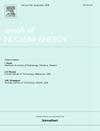Synthesis and radiation attenuation properties of polymethyl methacrylate/apatite-wollastonite composites for advanced shielding applications
IF 1.9
3区 工程技术
Q1 NUCLEAR SCIENCE & TECHNOLOGY
引用次数: 0
Abstract
This study investigated the microstructure and radiation shielding properties of Polymethyl Methacrylate (PAMM) doped with 5 %, 10 %, 15 %, and 20 % nano-grade pulverized Apatite-Wollastonite (AW) to form a biocompatible material with potential in medical radiation shielding and brachytherapy applications. X-ray diffraction (XRD) and Scanning electron microscopy (SEM) were used to characterize the microstructure and phase composition of the prepared composites. The radiation attenuation properties of the composite were theoretically evaluated for the linear attenuation coefficient (LAC), mass attenuation coefficient (MAC), Effective atomic number (Zeff), High-value layer (HVL), Mean free path (MFP) and Effective neutron removal cross-sections (ΣR). The results showed that integrating Apatite-Wollastonite with high radiation attenuation coefficients, into the PMMA matrix enhances the shielding effectiveness of the resultant composite while preserving the necessary mechanical properties. The polymer composite with 20 % AW (P-A-4) exhibited the maximum LAC of 0.038 cm−1 at 15 MeV and ΣR of 0.03965 cm−1, making it a potential candidate for shielding applications in medical settings, such as around X-ray machines and brachytherapy sources.
高级屏蔽用聚甲基丙烯酸甲酯/磷灰石-硅灰石复合材料的合成及辐射衰减性能
本研究研究了掺入5%、10%、15%和20%纳米级磷灰石-硅灰石粉(AW)的聚甲基丙烯酸甲酯(PAMM)的微观结构和辐射屏蔽性能,以形成具有生物相容性的医用辐射屏蔽和近距离治疗应用潜力的材料。利用x射线衍射(XRD)和扫描电镜(SEM)对制备的复合材料的微观结构和相组成进行了表征。通过线性衰减系数(LAC)、质量衰减系数(MAC)、有效原子序数(Zeff)、高值层(HVL)、平均自由程(MFP)和有效中子去除截面(ΣR)对复合材料的辐射衰减性能进行了理论评价。结果表明,在PMMA基体中加入具有高辐射衰减系数的磷灰石-硅灰石,可以增强复合材料的屏蔽效果,同时保持必要的力学性能。含有20% AW (P-A-4)的聚合物复合材料在15 MeV下的最大LAC为0.038 cm - 1, ΣR为0.03965 cm - 1,使其成为医疗环境中屏蔽应用的潜在候选者,例如x射线机和近距离治疗源周围。
本文章由计算机程序翻译,如有差异,请以英文原文为准。
求助全文
约1分钟内获得全文
求助全文
来源期刊

Annals of Nuclear Energy
工程技术-核科学技术
CiteScore
4.30
自引率
21.10%
发文量
632
审稿时长
7.3 months
期刊介绍:
Annals of Nuclear Energy provides an international medium for the communication of original research, ideas and developments in all areas of the field of nuclear energy science and technology. Its scope embraces nuclear fuel reserves, fuel cycles and cost, materials, processing, system and component technology (fission only), design and optimization, direct conversion of nuclear energy sources, environmental control, reactor physics, heat transfer and fluid dynamics, structural analysis, fuel management, future developments, nuclear fuel and safety, nuclear aerosol, neutron physics, computer technology (both software and hardware), risk assessment, radioactive waste disposal and reactor thermal hydraulics. Papers submitted to Annals need to demonstrate a clear link to nuclear power generation/nuclear engineering. Papers which deal with pure nuclear physics, pure health physics, imaging, or attenuation and shielding properties of concretes and various geological materials are not within the scope of the journal. Also, papers that deal with policy or economics are not within the scope of the journal.
 求助内容:
求助内容: 应助结果提醒方式:
应助结果提醒方式:


